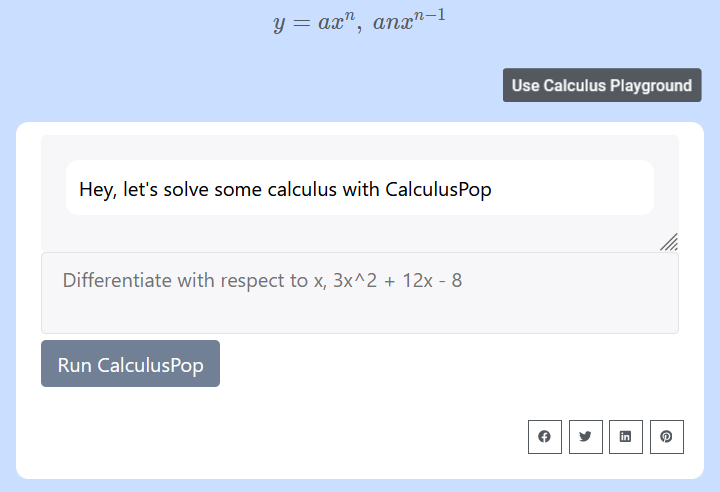step by step
calculus solver
1. Constant Expressions: Easily computes the derivative of constant terms, which always yield zero (e.g., \( 7 \)).
2. Single Variable Differentiation: Handles basic differentiation of single variables like \( x \), where \( \frac{d}{dx}(x) = 1 \).
3. Linear Expressions: Solves linear equations like \( ax \), providing instant results (e.g., \( 5x \) yields 5).
4. Power Rule: Applies the power rule to expressions like \( x^n \) (e.g., \( x^4 \) becomes \( 4x^3 \)).
5. Sum or Difference of Functions: Differentiates terms added or subtracted (e.g., \( x^2 + 3x - 1 \)).
6. Product Rule: Solves expressions where two functions are multiplied (e.g., \( x \cdot e^x \)).
7. Quotient Rule: Differentiates complex quotients (e.g., \( \frac{3x}{x^2 + 1} \)).
8. Chain Rule for Composite Functions: Handles the differentiation of nested functions (e.g., \( \sin(2x) \) or \( \log(4x^2) \)).
9. Trigonometric Functions: Works with functions like \( \sin(x) \), \( \cos(x) \), \( \tan(x) \), and more.
10. Exponential and Logarithmic Functions: Differentiates expressions such as \( e^x \) and \( \log(x) \).
1. 5
2. x
3. 4x
4. x^3
5. x^2 + 3x - 1
6. x^2 * e^x
7. (2x) / (x^2 + 1)
8. sin(2x)
9. log(3x^2)
10. cos(x)
11. e^x
12. tan(x^3)
13. x^4 + 5x^3 - 2x + 8
14. exp(2x)
15. 3x / (x^2 + 4)
16. x^5 * log(x)
17. (x^2 + 2x + 1)^3
18. cos(4x) * e^x
19. log(x) / x^2
20. sin^2(x)
21. e^(x^2)
22. 1 / (x^2 + 1)
23. 3x^2 - 4x + 6
24. tan(3x) * log(x)
25. (x + 1) / (x^2 - x)
26. x^2 * sin(x)
27. log(x^2 + 3x)
28. exp(x) * cos(x)
29. (x^2 - 4) / (x + 2)
30. sqrt(x) * log(x)
Worked Example 1
Expression: x^3 + 4x^2 - 5x + 2
Input in Raw Form
x^3 + 4x^2 - 5x + 2
Step-by-Step Output
1. Step 1: Apply the power rule to each term individually.
- \( \frac{d}{dx}(x^3) = 3x^2 \)
- \( \frac{d}{dx}(4x^2) = 8x \)
- \( \frac{d}{dx}(-5x) = -5 \)
- \( \frac{d}{dx}(2) = 0 \)
2. Step 2: Combine the results.
- The derivative is:
\[
\frac{d}{dx}(x^3 + 4x^2 - 5x + 2) = 3x^2 + 8x - 5
\]
Worked Example 2
Expression: sin(2x)
Input in Raw Form:
sin(2x)
Step-by-Step Output
1. Step 1: Recognize the composite function and apply the chain rule.
- Let \( u = 2x \), so \( \frac{d}{dx}(sin(2x)) = cos(2x) \cdot \frac{d}{dx}(2x) \).
2. Step 2: Differentiate the inner function.
- \( \frac{d}{dx}(2x) = 2 \).
3. Step 3: Multiply the results.
- The derivative is:
\[
\frac{d}{dx}(sin(2x)) = 2 \cdot cos(2x)
\]


